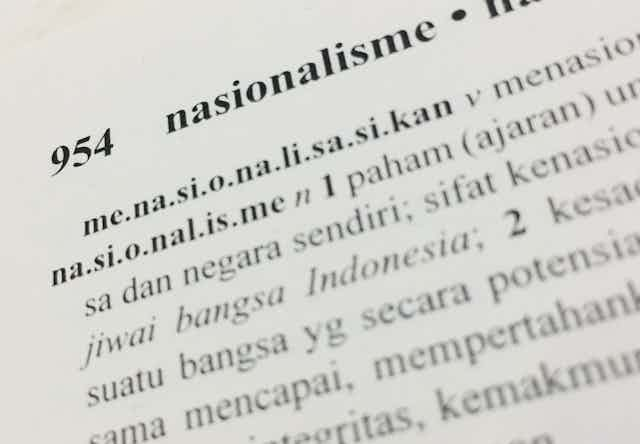Despite its tremendous language diversity, Indonesia as a nation is in favour of monolingualism. Approximately 700 languages are spoken across the archipelago, yet Indonesia chose to name one national and official language. But who actually speaks Indonesian?
Indonesia’s notable language policy has made it the “envy of the multilingual world”, according to linguist Joshua A. Fishman. This policy and the propaganda supporting it lead many Indonesians to believe that language functions as an important facilitator of unity. This policy was announced in the Youth Pledge (on unity) in 1928, commemorated annually on October 28, and consolidated during the New Order era.
Use of Indonesian measures Indonesian-ness
The construction of Indonesian-ness relies heavily on the use of Indonesian as our national language. Indonesians speaking other languages may find themselves being questioned on their nationalism. The language selection for many Indonesians is a space to make a correlation between language use, identity and nationalism.
Today, Indonesian continues to be cultivated and developed as both the national and official language. The government, through the Bureau of Language Development and Maintenance and the Education and Culture Ministry, assiduously promotes the use of standard Indonesian or “the good and proper” Indonesian.
Despite its significant function and its imposition by the government, throughout my graduate career I found that many Indonesians feel alienated from standard Indonesian.
Distant feeling towards (standard) Indonesian
These attitudes are recorded in my field notes, written during daily encounters with my fellow Indonesian students abroad, in the US and the Netherlands from 2006 to 2017.
Demographically, my respondents are predominantly graduate students coming from a number of cities and regions in Indonesia. In our daily conversation we noted we never actually spoke standard Indonesian.
When I went back home in August 2017, I interviewed a number of drivers for the ride-hailing app, Gojek, about the same topic in Depok, West Java, and Yogyakarta.
This time, I purposefully chose a different circle of professions to get more comprehensive and nuanced answers. I hoped they might reveal different answers from the young Indonesian scholars.
The Gojek riders and drivers come from a wide range of backgrounds, including housewives, undergraduate students and employees. Their level of education ranges from senior high school graduates to undergraduates.
The majority of the Gojek drivers made similar claims: they never used standard Indonesian in their daily encounters. Specifically for the drivers based in Yogyakarta, they speak Javanese, marginalising Indonesian in their daily exchanges. Yale linguist Joseph Errington states that Indonesian for many Javanese is an “un-native” language.
I also interviewed my high school friends and received a similar response. They rarely speak standard Indonesian. At the time of interview, most of my friends have finished undergraduate degrees and a few have pursued graduate study in Indonesia or overseas. The majority are professionals in mid-level career stages.
Most of my respondents, regardless of profession, say they do not really speak the standard language because it is too stiff and rigid (kaku, which is literally translated as firm), too poetic, too controlling, boring and too theatrical. They say they only see and hear it in the president’s long speeches, Indonesian textbooks and classroom discourse, among other arenas.
The use of colloquial Indonesian
All of the groups clearly distance themselves from the only official and national language of the nation. They prefer using their non-standard Indonesian or Indonesian with colloquial dialect, which varies from one city to another.
I noted some respondents often question the sufficiency of their Indonesian because it is heavily influenced by their regional languages or foreign languages, notably English. They were wondering whether they speak Indonesian at all, highlighting the stark differences between their variance and standard Indonesian.
For many, it may be safely assumed that standardised Indonesian has never been a native language because they do not acquire it as the mother tongue. The majority of my respondents claim that they learn the standard language as a government-imposed language via the school curriculum and other “formal” discourses.
The sentiment my respondents share about the formality of standard Indonesian positions the language as “other”. Apparently, many Indonesians question the de-facto status of standard Indonesian, the bona fide national language.
Colloquial Indonesian: is it Indonesian language?
Extending these observations, I wondered whether any of us actually speak Indonesian at all. Errington claims the differences between standard Indonesian and the Indonesian with vernacular dialects as a “diglossia” where standard Indonesian is the “High” form, and others are the “Low” form.
Another refreshing and unflappable opinion comes from a prominent Indonesian linguist based in Australia, James Sneddon. In his book Sneddon says the sub-standards or dialects of Indonesian spoken by the majority of Indonesians are Indonesian regardless. They may not be considered “good and proper”, but “modern Indonesian” is a lively language used in different forms and variants.
Just like any other live languages in the world, Indonesian will continue to grow while adopting and absorbing new words from other languages and having an ongoing contact with other languages.
We may celebrate Indonesian as our language of unity, but we need to be open-minded about Indonesian outside the government-imposed standard. I believe we can still claim our Indonesian-ness while speaking daily Indonesian.


